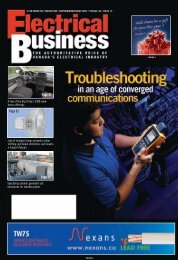FIRE ALARMS: the missing pieces - Electrical Business Magazine
FIRE ALARMS: the missing pieces - Electrical Business Magazine
FIRE ALARMS: the missing pieces - Electrical Business Magazine
You also want an ePaper? Increase the reach of your titles
YUMPU automatically turns print PDFs into web optimized ePapers that Google loves.
In <strong>the</strong> past, strobes were used only where hearing<br />
protection was required, but now <strong>the</strong>y’re found<br />
in many more locations. There are specific code<br />
requirements as to location (ULC S524-01, Section<br />
5.4.6.) and light intensity level, which is expressed<br />
in candelas (Annex C, tables C16 and C17). For one<br />
manufacturer, <strong>the</strong> load per device varies from 0.07A<br />
to 0.3A for strobes at 15 cd to 110 cd, respectively.<br />
Designers typically don’t indicate <strong>the</strong> load on <strong>the</strong><br />
signal circuits, nor <strong>the</strong> schematic. They leave it to<br />
<strong>the</strong> contractor, who is used to horn circuits where<br />
each device only draws about 0.04A (and <strong>the</strong>re’s<br />
<strong>the</strong> danger). Always request <strong>the</strong> candela level. If <strong>the</strong><br />
designer does not give it, <strong>the</strong>n do not bid <strong>the</strong> job.<br />
O<strong>the</strong>rwise, this situation can lead to overloaded<br />
signal circuits, voltage drop problems, or overloaded<br />
power supplies. This means a lot of rewiring and<br />
replacing burnt power supplies.<br />
Some more on strobes<br />
Strobes can trigger epileptic seizures in some people.<br />
Research seems to show that <strong>the</strong> flashes are to be<br />
limited to a rate of three flashes per second. Also,<br />
when in colour, avoid rapid changes between red and<br />
blue. The designer will typically put into <strong>the</strong> tender<br />
that <strong>the</strong> strobes are not to cause seizures (again, <strong>the</strong><br />
contractor is put on <strong>the</strong> spot). Luckily, you can get<br />
strobes that flash slowly at a constant colour.<br />
TROUBLE: So, if a hotel operator asks you to<br />
replace all existing fire bells with horn-strobes, know<br />
that it’s a big job. If you just do like-for-like replacement,<br />
it won’t just be <strong>the</strong> fire alarm panel that will<br />
be in ‘trouble’ mode.<br />
Signal circuits<br />
Each circuit is typically rated at about 1.5A, yet <strong>the</strong><br />
number of devices per circuit can vary by a factor<br />
of four. Manufacturers have specific data for <strong>the</strong>ir<br />
own devices, so don’t assume all signal devices draw<br />
<strong>the</strong> same current. In one job where we installed<br />
explosionproof horns, one manufacturer’s device<br />
drew three times <strong>the</strong> current of ano<strong>the</strong>r. (Note that<br />
explosionproof horns typically cannot sound <strong>the</strong><br />
temporal mode. A separate circuit is required with<br />
temporal mode initiated in <strong>the</strong> fire alarm panel.)<br />
Voltage drop<br />
The distance you can run a circuit drops dramatically<br />
as <strong>the</strong> circuit is loaded. These, after all, are only<br />
24V circuits. Manufacturers have different voltage<br />
drop tolerances for <strong>the</strong>ir devices. Some accept 3.4V<br />
drop whereas o<strong>the</strong>rs accept only 1.9V. Make sure<br />
you obtain <strong>the</strong> manufacturer’s voltage drop charts.<br />
Voltage drop is calculated based on measurements<br />
to <strong>the</strong> last device. In a four-wire system where <strong>the</strong><br />
EOL is at <strong>the</strong> panel, you do not measure <strong>the</strong> return.<br />
And don’t be surprised when you have several circuits<br />
and you’re using #12 wire instead of #16.<br />
Power supplies<br />
The fire alarm panel is usually designed to accommodate<br />
several circuits but, unfortunately, not all<br />
power supplies can accommodate all circuits when<br />
<strong>the</strong>y’re loaded (i.e. three circuits of 1.5A but a power<br />
supply of only 2.5A). Boosters for <strong>the</strong> power supply<br />
can be added (at extra cost) when ordered as part of<br />
<strong>the</strong> manufacturer’s package. In one plant, we had<br />
to install a remote booster supply to energize <strong>the</strong><br />
fur<strong>the</strong>st horn-strobe circuits. A monitoring module<br />
was also required to advise <strong>the</strong> main panel of any<br />
‘trouble’.<br />
Smoke detector sensitivity<br />
testing–addressable systems<br />
All smoke detectors have to be tested for functionality<br />
and for sensitivity. Functionality involves<br />
smoke injection testing to ensure system activation.<br />
Sensitivity involves testing with calibrated instruments<br />
to ensure <strong>the</strong> detector is within its rated operating<br />
range. Testing requirements are spelled out in<br />
ULC S536-04.<br />
For addressable systems, however, <strong>the</strong>re are some<br />
doubts with self-diagnostic sensitivity testing. Do<br />
we accept <strong>the</strong> results, or do we perform field testing?<br />
Clause 5.7.4.1.6 is clear: <strong>the</strong> self-diagnostic function<br />
provided in most addressable fire alarm systems is acceptable.<br />
(This is significant from a cost perspective when you consider<br />
that each smoke detector can take anywhere from five to 10 minutes<br />
to test with portable field testing equipment.)<br />
Testing fixed-temperature<br />
detectors–non-addressable systems<br />
Fixed-temperature detectors are installed where temperature rise<br />
is 15˚F per minute or faster (i.e. boiler rooms). In non-addressable<br />
systems, rate-of-rise detectors will reset automatically. It<br />
is not possible to find <strong>the</strong> location of <strong>the</strong> heat detector in a<br />
‘false alarm’ condition. The usual result is that <strong>the</strong> rate-of-rise is<br />
replaced by fixed-temperature detectors that do not reset. This<br />
is not an issue in addressable systems, where fixed-temperature<br />
detectors are resettable, and panel software indicates exactly<br />
which device is activated.<br />
Incidentally, rate-of-rise testing on non-resettable detectors<br />
destroys <strong>the</strong>m. Until about 10 years ago, <strong>the</strong> standard required<br />
10% testing (destruction) and replacement of devices. This<br />
requirement no longer exists. The extent of testing now involves<br />
visual inspection to identify any external damage and a short<br />
across <strong>the</strong> wiring terminals to verify alarm activation.<br />
�� �� � ��������� �� ��� ���� ����� ������� �� ������� ��� �� � ��������� �� �������� ���� ���� ���������� �� �� �� �������<br />
3M is a Trademark of 3M. Used under license in Canada. TTS is a trademark of Thermon.<br />
Used with permission by 3M in Canada. 0703-CP-28484 E BA-07-11824<br />
At least one manufacturer supplies fixed-temperature resettable<br />
detectors with an LED signal that stays on until <strong>the</strong> panel<br />
is reset. This detector has a higher initial cost, but saves a lot<br />
of time in <strong>the</strong> annual inspection. Fur<strong>the</strong>rmore, <strong>the</strong> device is<br />
tested—not just <strong>the</strong> terminal strip—and doesn’t need to be<br />
replaced after activation.<br />
Registration of a certified fire alarm technician<br />
As mentioned earlier, a technician who has passed all his courses<br />
and exams must go through a Trainee program, where he spends<br />
a year as an ‘apprentice’ to a Registered Technician. A report<br />
about <strong>the</strong> Trainee is written up at <strong>the</strong> end of his training.<br />
But what happens when <strong>the</strong> Trainee is <strong>the</strong> first in <strong>the</strong> company<br />
to go through <strong>the</strong> courses and exams, and has no one with<br />
whom he can ‘apprentice’? CFAA provides a several solutions,<br />
including:<br />
a verification by a registered technician from ano<strong>the</strong>r company;<br />
a letter from a member of <strong>the</strong> Fire Department who knows<br />
<strong>the</strong> applicant and can verify he has worked in <strong>the</strong> fire alarm<br />
industry and on systems; and<br />
a detailed list of a minimum of 10 jobs in which <strong>the</strong> applicant<br />
has performed fire alarm work.<br />
continued on p.15<br />
����� ����<br />
���������� ��������� ����������<br />
����� ��� ��� ���� ���������� ���� �� � ��� � ���� �������<br />
���� �� ����� ��� ���� ������ ����������� ���� ��� ������<br />
�������� �� ����� ����� ����������� ����� �� ���� ��� �����<br />
���� ��� �� ������� �� ������ �� ���� ��� ���������<br />
��� ���� ���� ���������� ���� ������� ������� ����<br />
�� ���� ������ �� ��� ������ ������ ��� ��������� ����� �� ���<br />
������� �������� ��������� ����� ���� ������� ��� ����<br />
���� ������� ����� �� �� �� ��� ����� ������ �� ������<br />
������� ���� ��� ��� ��� ���� ��������� ���� ����� ��<br />
���� ��� �� ��� �����<br />
��� ���� ����������� �� �� � ���� �������<br />
�������� ������ ������� ���� �����<br />
�� �������������� �� ���� ��������������<br />
3M_7x10_EB_April07.indd 1 3/27/07 2:37:02 PM<br />
www. mag.com MAY 2007 13<br />
INFO NO. 17

















